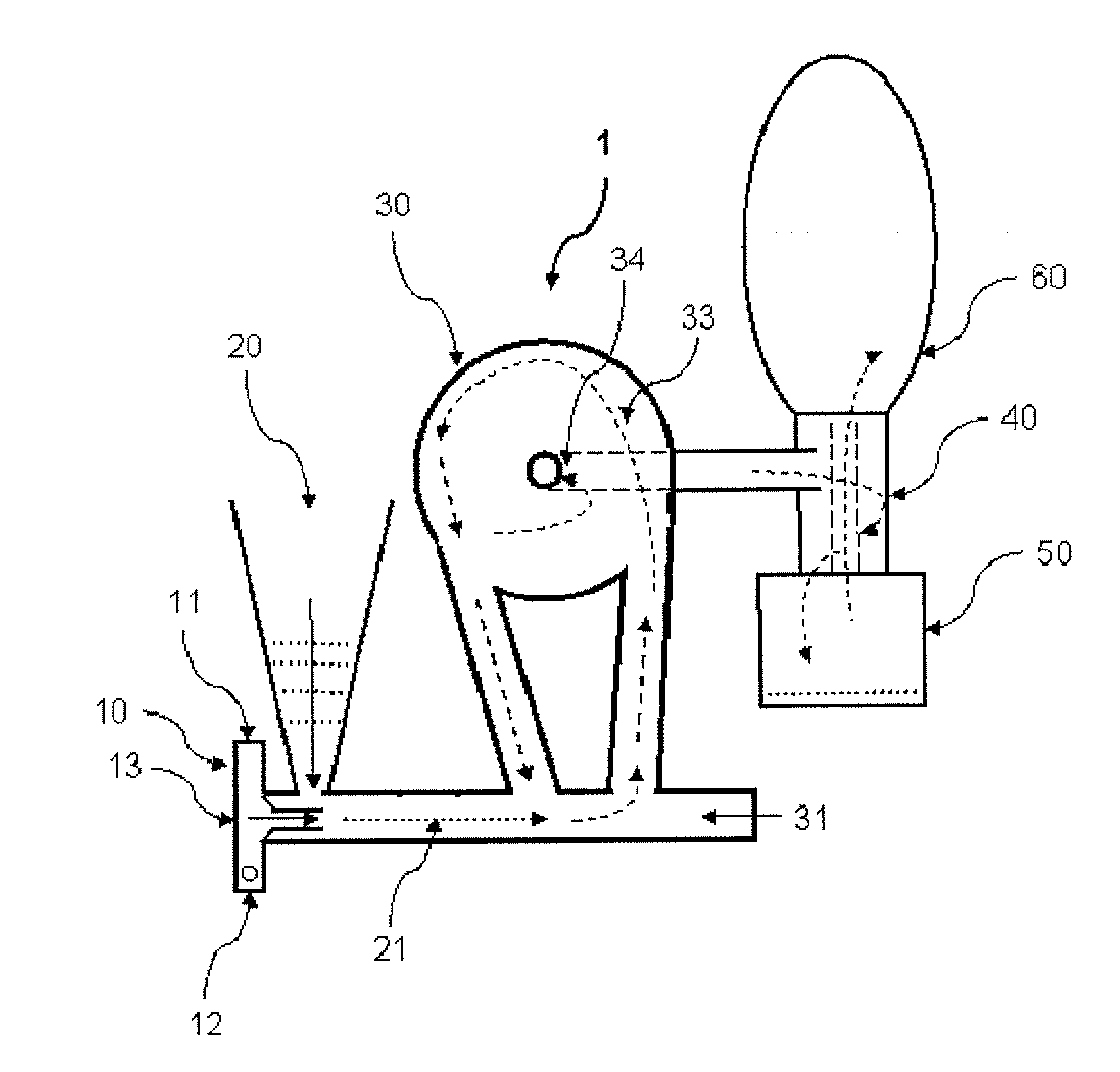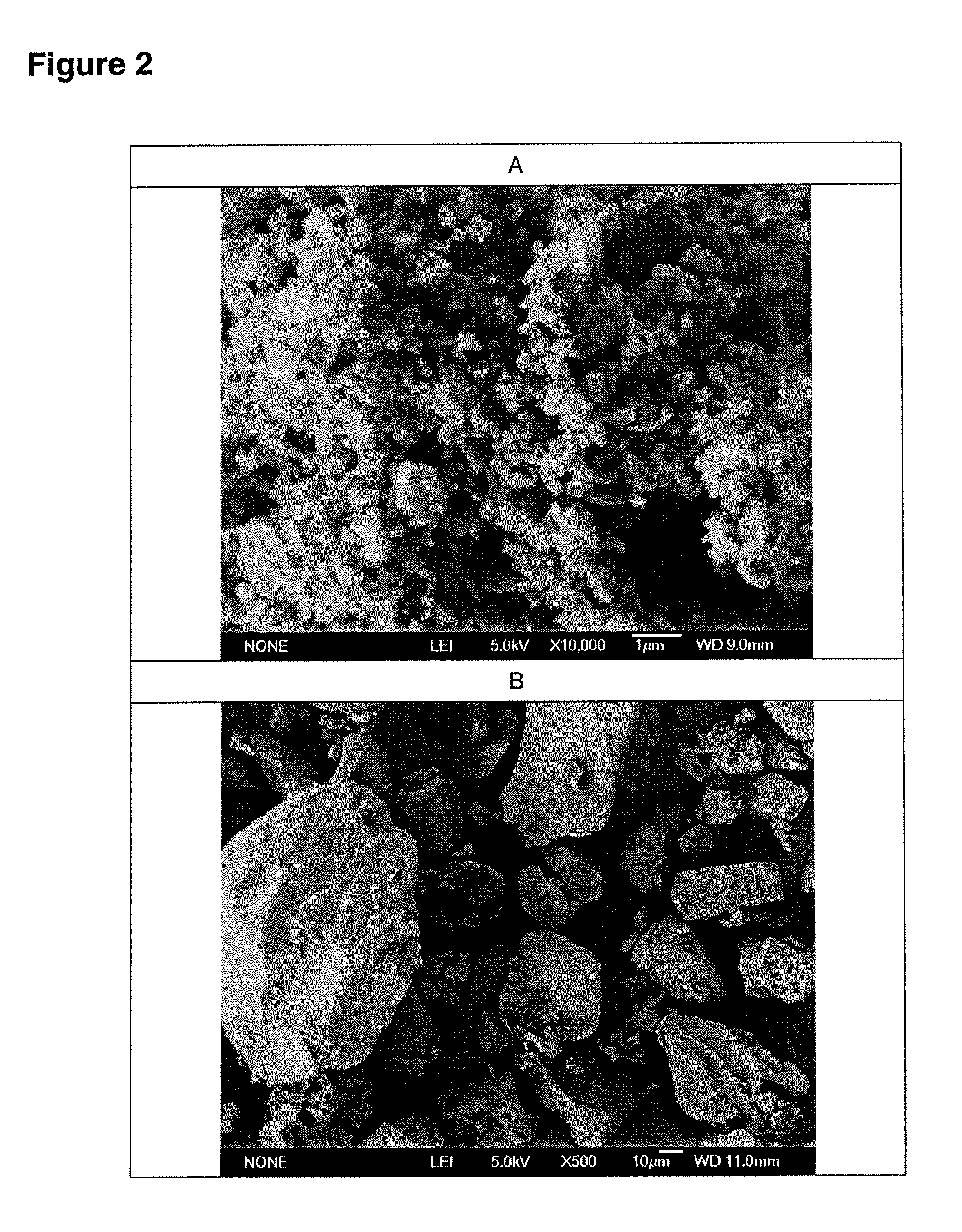Process for milling and preparing powders and compositions produced thereby
a technology of powder and composition, which is applied in the direction of powder delivery, grain treatment, etc., can solve the problems of high cost, excessive consumption of time and energy, and difficult or impossible to mill to a fine grain size, and achieve the effect of improving the efficiency of particle size reduction and low cos
- Summary
- Abstract
- Description
- Claims
- Application Information
AI Technical Summary
Benefits of technology
Problems solved by technology
Method used
Image
Examples
example 1
[0086]Lactose / 2% leucine (100 g) powders were prepared using low-frequency sonication drying according to WO 03 / 090717. The mixture was allowed to freeze overnight (−5° C., Kenmore Freezer) and then placed in a funnel connected to Bransonic spoon feeder attached to Trost Gem-T jet mill. A liquid and gas nitrogen mixture (from metal liquid nitrogen dewar, Praxair) was adjusted resulting in a flow of 100 to 180 CFM (80 to 100 psi combined input pressure) and a temperature of −2 Celsius above the cyclone read from a TSI Model 4040 Flowmeter. The powder was fed into the mill over 5 minutes and the resulting powder in the cup below the cyclone passed again through the mill three additional passes. The resulting white powder in the cup and bag was obtained with a yield of 92 g, containing particles with a diameter less than 10 microns and highly electrostatic. The particles obtained could be used as a carrier for use in a dry powder inhaler or oral capsule formulation.
example 2
[0087]Spray-dried gentamicin sulfate USP (80 g, Hawkins), inhalation-grade lactose (16 g, Respitose, DMV), sodium chloride (2 g, Fisher), and I-leucine (2 g, Spectrum) was mixed in a turbula mixer (Glen Mills) at room temperature for 10 minutes. The resulting dry mix was then granulated in a shear mixer with water. The wet granulation was then spread into a stainless steel bowl and dried in an oven at 40 Celsius for 2 days. The dried granules were then milled through an 18 mesh (1 mm) screen. The mixture was allowed to freeze overnight (−5 Celsius, Kenmore Freezer) and milled similar to the method of EXAMPLE 1. The powder was fed into the mill over 5 minutes and the resulting powder in the cup below the cyclone passed again through the mill three additional passes. The resulting white powder in the bag was obtained with a yield of >60 g, containing particles with a diameter less than 10 microns and highly electrostatic. The particles obtained could be used as an inhaled antibiotic t...
example 3
[0090]Acyclovir, USP (Hawkins), PVP K-30 (ISP), and zinc acetate (Spectrum), powders (80 g, 1:2:5 ratio by mass) were mixed in a turbula mixer (Glen Mills) at room temperature for 10 minutes. Similar to EXAMPLE 1, the mixture was placed in a funnel connected to Bransonic spoon feeder attached to Trost Gem-T jet mill. A liquid and gas nitrogen mixture was adjusted resulting in a pressure of 90 psi (+ / −10 psi) in each jet. The powder was fed into the mill over approximately 5 minutes and the resulting powder in the cup below the cyclone passed again through the mill three additional passes. The resulting white powder in the bag was obtained with a yield of >60 g, containing particles with a diameter less than 10 microns and highly electrostatic. The particles obtained could be used to fill capsules or added to a heated propylene glycol / aqueous solution in preparation of a clear hydrogel for topical application.
PUM
 Login to View More
Login to View More Abstract
Description
Claims
Application Information
 Login to View More
Login to View More - R&D
- Intellectual Property
- Life Sciences
- Materials
- Tech Scout
- Unparalleled Data Quality
- Higher Quality Content
- 60% Fewer Hallucinations
Browse by: Latest US Patents, China's latest patents, Technical Efficacy Thesaurus, Application Domain, Technology Topic, Popular Technical Reports.
© 2025 PatSnap. All rights reserved.Legal|Privacy policy|Modern Slavery Act Transparency Statement|Sitemap|About US| Contact US: help@patsnap.com



